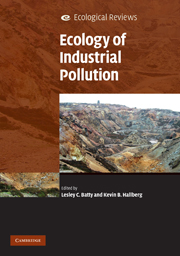Book contents
- Frontmatter
- Contents
- List of contributors
- Preface
- Acknowledgements
- 1 Consequences of living in an industrial world
- 2 Metallophytes: the unique biological resource, its ecology and conservational status in Europe, central Africa and Latin America
- 3 Lichens and industrial pollution
- 4 The impacts of metalliferous drainage on aquatic communities in streams and rivers
- 5 Impacts of emerging contaminants on the environment
- 6 Ecological monitoring and assessment of pollution in rivers
- 7 Detecting ecological effects of pollutants in the aquatic environment
- 8 With the benefit of hindsight: the utility of palaeoecology in wetland condition assessment and identification of restoration targets
- 9 An ecological risk assessment framework for assessing risks from contaminated land in England and Wales
- 10 Diversity and evolution of micro-organisms and pathways for the degradation of environmental contaminants: a case study with the s-triazine herbicides
- 11 The microbial ecology of land and water contaminated with radioactive waste: towards the development of bioremediation options for the nuclear industry
- 12 The microbial ecology of remediating industrially contaminated land: sorting out the bugs in the system
- 13 Ecological recovery in a river polluted to its sources: the River Tame in the English Midlands
- 14 Manchester Ship Canal and Salford Quays: industrial legacy and ecological restoration
- 15 Large-scale mine site restoration of Australian eucalypt forests after bauxite mining: soil management and ecosystem development
- 16 Sustaining industrial activity and ecological quality: the potential role of an ecosystem services approach
- Index
- Plate section
- References
3 - Lichens and industrial pollution
Published online by Cambridge University Press: 05 June 2012
- Frontmatter
- Contents
- List of contributors
- Preface
- Acknowledgements
- 1 Consequences of living in an industrial world
- 2 Metallophytes: the unique biological resource, its ecology and conservational status in Europe, central Africa and Latin America
- 3 Lichens and industrial pollution
- 4 The impacts of metalliferous drainage on aquatic communities in streams and rivers
- 5 Impacts of emerging contaminants on the environment
- 6 Ecological monitoring and assessment of pollution in rivers
- 7 Detecting ecological effects of pollutants in the aquatic environment
- 8 With the benefit of hindsight: the utility of palaeoecology in wetland condition assessment and identification of restoration targets
- 9 An ecological risk assessment framework for assessing risks from contaminated land in England and Wales
- 10 Diversity and evolution of micro-organisms and pathways for the degradation of environmental contaminants: a case study with the s-triazine herbicides
- 11 The microbial ecology of land and water contaminated with radioactive waste: towards the development of bioremediation options for the nuclear industry
- 12 The microbial ecology of remediating industrially contaminated land: sorting out the bugs in the system
- 13 Ecological recovery in a river polluted to its sources: the River Tame in the English Midlands
- 14 Manchester Ship Canal and Salford Quays: industrial legacy and ecological restoration
- 15 Large-scale mine site restoration of Australian eucalypt forests after bauxite mining: soil management and ecosystem development
- 16 Sustaining industrial activity and ecological quality: the potential role of an ecosystem services approach
- Index
- Plate section
- References
Summary
Introduction
Lichens are composite organisms including at least one fungus (mycobiont) and an alga or cyanobacterium (photobiont) living in a mutualistic symbiosis (Hawksworth & Honegger 1994). The lichen symbiosis may involve multiple and different bionts, especially photobionts, at various stages of its life history (Hawksworth 1988; Jahns 1988). Lichenised fungi are ecologically obligate biotrophs acquiring carbon from their photobionts (Honegger 1997). Lichens colonize bark, rocks, soil and various other substrata, and occur in all terrestrial ecosystems, covering more than 6% of the Earth's land surface. They are dominant in Arctic and Antarctic tundra regions where they form the key component of ecosystem processes, as a part of global biogeochemical cycles and also the food chain. Arctic and sub-Arctic lichen heaths are readily visible from space using remote sensing techniques and the effects of ‘point source’ smelters in creating ‘industrial barrens’ and emission reductions leading to recovery of Cladonia-rich heaths are well-documented (Tømmervik et al. 1995, 1998, 2003).
Lichens play a major role in plant ecology and the cycling of elements, such as C, N, P, heavy metals and radionuclides (Knops et al. 1991; Nash 1996b) and are extremely tolerant of ionising radiation (Brodo 1964). Lichens contribute to soil formation and stabilization (Jones 1988). Lichenized fungi may well be ancestral to fruit-body forming ascomycetes (Eriksson 2005). There are around 13,500 known species and 18,000–20,000 estimated worldwide (Sipman & Aptroot 2001).
- Type
- Chapter
- Information
- Ecology of Industrial Pollution , pp. 41 - 69Publisher: Cambridge University PressPrint publication year: 2010
References
- 6
- Cited by



